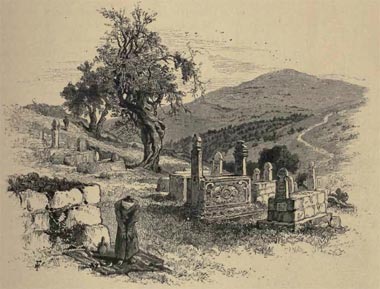Wednesday, 31 March 1858
Slept better, but did not rise till nearly 7. ― Giorgio bought me various Jerusalem articles ― beads &c. &c. &c.
Breakfast ― after which came Mahmoud & Abd=el=Malak, & with writings of Ibrahim. Mr. Turner (for the 3 going to East Jordan,) was with me, ― & the discourse ended by my settling with Abd-el-Malak ― to take him for 1 month ― at 30/- a day ― by Bethlehem & Hebron, & afterwards as may happen.
Abd el Malak ― a long black Assirott Copt, seems a good sort of man ― & at all events don’t talk much. Wrote & packed till lunch ― & afterwards went to get the Contract Signed at Mr. Φinn’s ― but he was out or unwell… so I returned, ― & buying a saddle, set off with Messrs Macan & Sykes & Lord Dunglass ― to the Latin Convent, where we bought mother of pearl objects. ― Then we went to the Damascus Gate ― & to the tomb of Helena ― (Queen of Adiabene,)1 & after that, Dunglass & Sykes walked on, & I & Macan slowly afterwards ― along the valley of Jehosaphat, Giorgio behind. Beautiful & curious flowers ― & a silent rural space of olives, & grey rocks around. Black fat soiled Syrian Sheep ― & picturesque shepherds. Coming to the road to St. Stephen’s Gate, I drew a lot; what pictures of masses of black white headed sheep winding up the roads! the white robed Turkish women, & the bird hued Syrian peasant. ― We walked on by the golden gates, & finding Lord Dunglass & Sykes, ― all together to Zion Gate, ― after which Sykes & I were alone ― a great bore, for I am not tolerant, & Sykes is silly. ― Dinner ― merry & pleasant.
[Transcribed by Marco Graziosi from Houghton Library, Harvard University, MS Eng. 797.3.]
- Helena was queen of Adiabene and wife of Monobaz I. Helena became a convert to Judaism about the year 30 AD. She was noted for her generosity; during a famine at Jerusalem she sent to Alexandria for corn and to Cyprus for dried figs for distribution among the sufferers from the famine (Josephus, l.c. § 5.) When Helena died, about 56 AD, her son or grandson Monobaz II moved her remains to Jerusalem, where they were buried in the pyramidal tomb which she had constructed during her lifetime, three stadia north of Jerusalem (Eusebius, “Hist. Eccl.” ii., ch. 12.). [↩]

